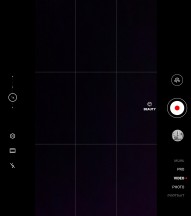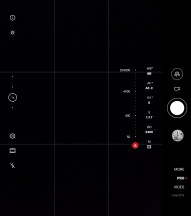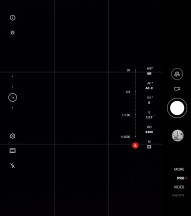Huawei Mate Xs review

SuperSensing Leica Quad Camera
Despite its size limitations, the Mate Xs still manages to offer a very potent quad-camera setup. While it is not exactly on the level of Huawei's current-gen setups, as seen in the P40 family, it is nothing to scorn at. The overall setup seems to be close to the one found in the Huawei P30. A fact that makes a lot of sense when we consider that the original design for the Mate Xs, or rather the Mate X was developed a while back and a camera swap and refresh would definitely require a more serious overhaul.

First up, we have the main 40MP, 1/1.7" sensor. It is one of Huawei's signature RYYB filter designs, which is advertised to offer better light-gathering abilities, among other things. It is a Bayer design, intended to produce 10MP images. Though, shooting at the full 40MP is also possible, with some compromises involved.
It is worth noting that this is not the best implementation we have seen of this particular camera module. The P30 Pro, for instance, has it sitting behind a brighter f/1.6 lens, instead of the f/1.8 one on the Mate Xs and also includes OIS and Laser AF for it. These are hardly major handicaps on the Mate Xs, which still has a plenty potent snapper at its disposal.
Plus, two more. Or three. Depending on whether you count the supplementary 3D TOF depth sensor. The 16MP, f/2.2, 17mm ultrawide seems very similar to the one on the Huawei P30, as well. Once again, it is missing Laser AF, though, and it only relies on PDAF instead. We would much rather focus on the fact that the module includes autofocus at all, which makes it capable of macro shots as close as 2.5cm away from the subject.

Finally, the 8MP telephoto. Huawei advertises it as offering a 3x optical zoom, as calculated from the 17mm ultrawide. Also, 5x hybrid zoom and up to 30x digital. It is also the only camera out of the bunch to actually include OIS. To be fair, the other two modules do perfectly fine with AIS (Huawei Ai Image Stabilization) EIS. But, more on that later.





Basic camera UI, modes and filters
Before we move on to camera quality, we should take a look at the camera app, its UI and features. Nothing is really out of the Huawei ordinary here. A shutter key on the right, alongside a switch to enable selfie mode.
Now, the Selfie mode operates in a rather interesting way, as you can imagine. It requires the phone to be folded and then instructs you to turn the unit around, with the main camera facing you. This is actually one of the few scenarios in which you get to use the rear 6.38-inch portion of the display.
In fact, any use case that requires a selfie camera - be it a video call, or app that calls upon a "selfie camera" will result in a flip to the rear display.
The mode selector/slider is pretty straight-forward. Its final entry houses a few additional modes. Things like Slow-MO, Panorama, Documents, Light painting, etc.
Some of the toggles on the left-hand side of the camera Ui are self-explanatory, like the settings shortcut and the flash controls. The film-strip-looking button actually brings up filters. The Ai button toggles Huawei's MASTER AI system. It is not on by default, but we made sure to test it out separately in all sorts of conditions.


There is really only one right way to hold it
One of the improvements that Huawei boasts about with the Kirin 990 5G chipset is a fifth-generation ISP, with 15% improvement in pixel throughput. We aren't exactly sure compared to what, though.
The ISP also comes with dual-domain noise reduction, improved low-light video performance and support for Block Matching and 3D filtering (BM3D), for up to 30% better noise reduction. We're only bringing this up here since we aren't quite sure whether some of these improvements are tied to enabling the MASTER AI mode or just work regardless.
Anyway, back to the camera UI. The last button on the left side enters a visual assistant mode, of sorts. It offers object recognition for shopping purposes, as well as barcode scanning.
The icon that looks a bit like a book is probably meant to be crude representation of the Mate Xs design. It toggles the rear display on and off. This can be done in both photo and video mode and enables the subject to follow along and look at the viewfinder during the shoot. Nifty feature and the only place we saw the Mate Xs make use of both its front and back displays simultaneously.
There is a Pro mode available. ISO controls range from 50 to 204,800 and shutter speed goes from 1/4000 to 30 seconds.
The Settings menus are different depending on which mode you enter them from. That keeps photos and videos separate and even allows for independent resolution control for the ultrawide.
This is how you turn on 40MP mode on the main camera. There could have probably been a more convenient toggle for that, though.
Video resolution only goes up to 4K. No high frame rate options beyond 60fps are available either.
There is no way we found to turn off stabilization in video. While that has been the Huawei norm for a while now, we would still like to see it change, eventually.
Shooting in unfolded mode is very much a thing and though it instinctively brings-up some negative associations with tablet photography, there is nothing really wrong with doing it on the Mate Xs. It still feels a bit awkward and there is only one feasible way of holding the phone and reaching the shutter key, without obstructing your view. That technically has the Mate Xs in portrait orientation. But, that's really not much of a concern with its unfolded dimensions.
Main camera image quality
Quality-wise, the Huawei Mate Xs unsurprisingly takes after the P30, from which it seems to borrow most of its camera hardware. However, the output is not a carbon copy. Instead it is clear that Huawei has managed to successfully build on top of what was already competent hardware and software, with even more refined processing.






Huawei Mate Xs 10MP main camera samples
Shots from the main camera come out in 3648 x 2736 pixels, or 10MP, by default and have plenty of detail to boot. Of course, a higher resolution camera could, potentially offer more, but this is more than adequate.
Speaking of details, particular fine geometric patterns here and there do come-out looking a bit different than they are in real life. That's just a part of the Bayer sensor experience. At least to some degree.



Huawei Mate Xs 10MP main camera samples
Dynamic range in these shots is great, so is uniformity. Huawei's color science might not be to everyone's taste, though. The approach involves a slightly more muted look than, say, what a recent Samsung Galaxy flagship would produce. A bit less sharpening overall, as well. Thant's not really a criticism, though. While both approaches definitely have their advantages, we would definitely refer to Huawei's approach as all-round mature processing.






Huawei Mate Xs 10MP main camera Master AI ON samples
The muted look of these shots can be attributed to the extra-cloudy weather we were experiencing. Most shots in such conditions could benefit from a touch of HDR. The Mate Xs does have a dedicated HDR mode, but that's not exactly what we had in mind since it produces really color-rich and saturated shots. Kind of the alternate meaning of HDR photography. There is, however, something called MASTER AI, available on a convenient toggle in the main camera interface. Its effects on most of our shots were subtle, yet enjoyable. It applies just a bit more sharpness to the frame and brings up the saturation slightly.
We definitely think that there is more optimization going on behind the scenes than the simple tweaks we just described. Since, applying those alone in post don't really get us the same results. Plus, on occasion, regardless of having the Ai toggle on or off, the camera UI would bring up a message that it is "sharpening" the image and we have to hold the phone steady. We hardly noticed differences between photos taken with that seemingly-random pop-up appearing and those without, so Master AI remains something different, entirely. We only saw benefits from keeping it on.
Like we already mentioned, you can go in and force the main 40MP camera to shoot in its native full-resolution. This offers little real-world benefits, since it's really not how the sensor is supposed to be used. Those "artistic" renditions of certain fine patterns, we mentioned earlier, tend to get really excessive in 40MP mode.






Huawei Mate Xs 40MP main camera samples
Applying MASTER AI is also possible in 40MP mode and has a pretty similar, generally beneficial effect to shots.






Huawei Mate Xs 40MP main camera Master AI ON samples
Before we move on to the other cameras and modes on the Mate Xs, there is one notable issue, we observed frequently while shooting with the main 40MP camera. On occasion, it simply decides to switch-up its white balance drastically and quite rapidly. We initially noticed this in 40MP mode and thought it might be related to it. However, the effect also manifested while shooting our ISO chart for the picture compare database. Low-light conditions understandably seemed to aggravate the behavior further. Hopefully, it's a relatively easy software fix.
Zoom camera image quality
Even though the telephoto camera on the Mate Xs has a native resolution on 8MP, it still outputs in the exact same 3648 x 2736 pixels, or 10MP the main snapper does. Meaning that there is definitely a slight touch of upscaling going on.






Huawei Mate Xs 3x zoom camera samples
Huawei advertises its 3x zoom level as optical, its 5x mode as hybrid zoom, and then, up to 30x is digital zoom, with all the small linear increments in-between. Naturally, we tested at these preset levels. At 3x images come out quite sharp and detailed, though there is a bit of haze in certain areas. Dynamic range understandably suffers a bit, compared to the main camera. But, on the plus side, colors tend to look comparable between the two. Perhaps a bit more saturated in the zoomed processing algorithm. Overall, we like the results.






Huawei Mate Xs 5x zoom camera samples
Some extra softness all-around the frame starts creeping-up in the 5x shots, which is perfectly natural. Unless you really zoom in and pixel-peep, though, shots remain perfectly usable.
You do need to be a bit more cautious with autofocus when zooming, though. While the PDAF system on the Mate Xs holds-up great, overall, it can sometimes miss a beat. In good lighting conditions, this happens way less often, than in nighttime. Though, it is worth noting that there seems to be an ongoing fight between the otherwise excellent OIS system, that really starts helping out at bigger zoom levels and the PDAF. Often time when the camera detects a bigger pan or accidental shake in the frame and the OIS + EIS adjust and slightly repositions the image to compensate, that triggers misbehavior from the autofocus. Just to be clear, though, the is mostly us nitpicking and hardly a major issue.






Huawei Mate Xs 30x zoom camera samples
30x shots can be made usable with a very steady hand, so as not to upset the autofocus too much, as per the issue described above and a few tries. The results never come out looking perfectly sharp, though. Still usable enough.






Huawei Mate Xs 3x zoom camera Master AI ON samples
Of course, we didn't skip Master AI for zoom shots. Its positive effects are there, but not really too consistent. Especially as you ramp-up the zoom level.






Huawei Mate Xs 5x zoom camera Master AI ON samples






Huawei Mate Xs 30x zoom camera Master AI ON samples
Ultrawide camera image quality
As far as its main purpose in concerned - capturing a wide scene, the 16MP snapper on the Mate Xs is competent, if not really too impressive.
There is noticeable softness all around the frame. Barrel distortion around the corners in on the more aggressive side. Dynamic range is naturally more limited than what we get with the main camera and colors tend to come out a bit more muted. There is just a bit more noise in these ultrawide shots, compared to the main camera, which we see as a win.






Huawei Mate Xs ultrawide camera samples
Master AI mode, unsurprisingly, improves uniformity, gets rid of some of the softness, and boosts saturation. There is an odd side effect from this mode on the ultrawide in particular, which might be coincidental. Still, we can't shake the feeling that photos shot with AI ended up with more barrel distortion on the left side of the frame and less on the right. Weird, we know.






Huawei Mate Xs ultrawide camera Master AI ON samples
Since the ultrawide on the Mate Xs has autofocus, Huawei is leveraging it for its macro mode. You can get really interesting results from this camera up close. Here are a couple of comparisons between it and the main 40MP camera.




Close-up shots: main camera • ultrawide • main camera • ultrawide
Just for the sake of an easier overview on the entire zoom range the Mate Xs is capable of, here is a single scene, shot in all of the above zoom levels and camera modes. Plus, the same one with Master AI on.






Huawei Mate Xs samples: ultrawide • main camera (1x) • 3x • 5x • 30x • 40MP main camera






Huawei Mate Xs samples Master AI: ultrawide • main camera (1x) • 3x • 5x • 30x • 40MP main camera
And here is the Huawei Mate Xs in our extensive camera compare database. Fell free to pixel-peep and compare.



Huawei Mate Xs against the Samsung Galaxy Fold and the Huawei P40 Pro in our Photo compare tool



Huawei Mate Xs against the Huawei Mate 30 Pro and the Huawei P30 Pro in our Photo compare tool at 40MP
Portraits and selfies
We are lumping these two together, since the Huawei Mate Xs has its main camera array pulling double duty as a selfie camera, as well. The rear display of the phone in folded mode is leveraged for this purpose.
Every time an app requests access to a "selfie" camera on an OS level, it automatically runs on the rear display, instead of the main one. One unfortunate consequence of this setup is that you can never have a video chat or use any of said apps on the full, unfolded 8-inch display.
Other than that, we found very little in the way of gripes with the selfie experience. There is the perplexing fact that you can not use the ultrawide camera while in selfie mode. That's not only a clearly artificial limitation, but also one that fails to make any sense at all since the ultrawide is equipped with autofocus and can even do macro shots of objects, as close as 2.5cm away from the camera. It would have been perfect for wide selfie shots.

As you can probably imagine, quality here is perfect, all round. So much so, I fact, that we were almost tempted to praise the Mate Xs as an amazing video blogging device. Which, indeed it is, as long as you can stomach the fact that every time you put it on a gimbal or a monopod and any standard phone mount, for that matter, you are essentially pressing down on its folded display on one side.

In terms of options, you get access to beauty filters in this mode. Huawei has a mostly light-handed approach to its beautification algorithm, which makes it a bit harder to complain that it is on by default. Still, worth noting.



Selfie beauty mode samples: Off • Medium • Max
There is a dedicated portrait mode on the Mate Xs. It is available on the main camera, as well as the telephoto, with a zoom level of 2x and up to 3x, with everything in between. Once again, not the ultrawide, which is a weird limitation to impose. There is also nothing preventing you from using it on yourself in selfie mode. At least that part is not disabled.
It comes with two menus - one for adjusting beautification and the other, chock-full of all sorts of effects. Some even bearing the Leica brand. You get convenient face detection, as well, which is a great indication of whether you are at the right distance and angle for the effect to actually recognize you properly.






Portrait mode: Off • On (various settings)
Results looks impressive, as they should, given the overall performance of the camera so far. Plus, the inclusion of a dedicated depth sensor in the camera array.
Reader comments
- Benetiq
- 18 Mar 2024
- SvB
Bought it in 2024, wonder why. First i had huawei p30 pro, them i Swiched from xiaomi 13 pro and realisez it's snapdragon that's consumin a lot of energy and wasting and heating.
- YUKI93
- 25 Oct 2021
- K1x
I can't help but think that LG or any other brand can use this phone as an inspiration for their rollable screen smartphone. I mean, the camera and the power+volume button is placed on one side with no bezel or notch or even punch-hole interrupt...
- PhomeGeek78
- 27 Mar 2021
- j}d
It comes with a pre installed screen protector. I've had mine 9 months it's still on there.





















